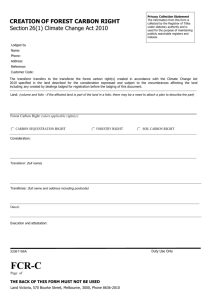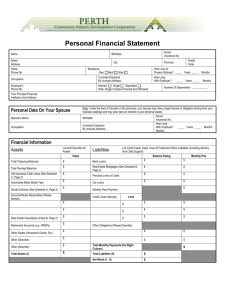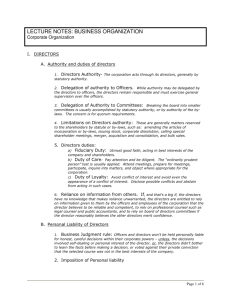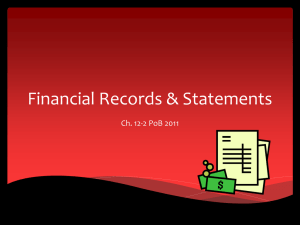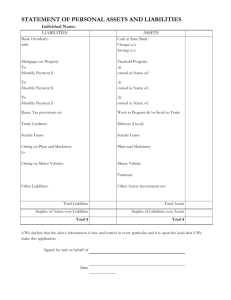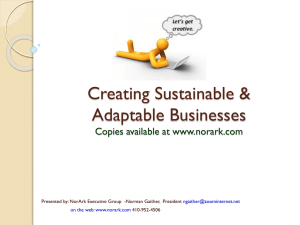Dealing with Liabilities Excess of Basis Under Section 351
advertisement
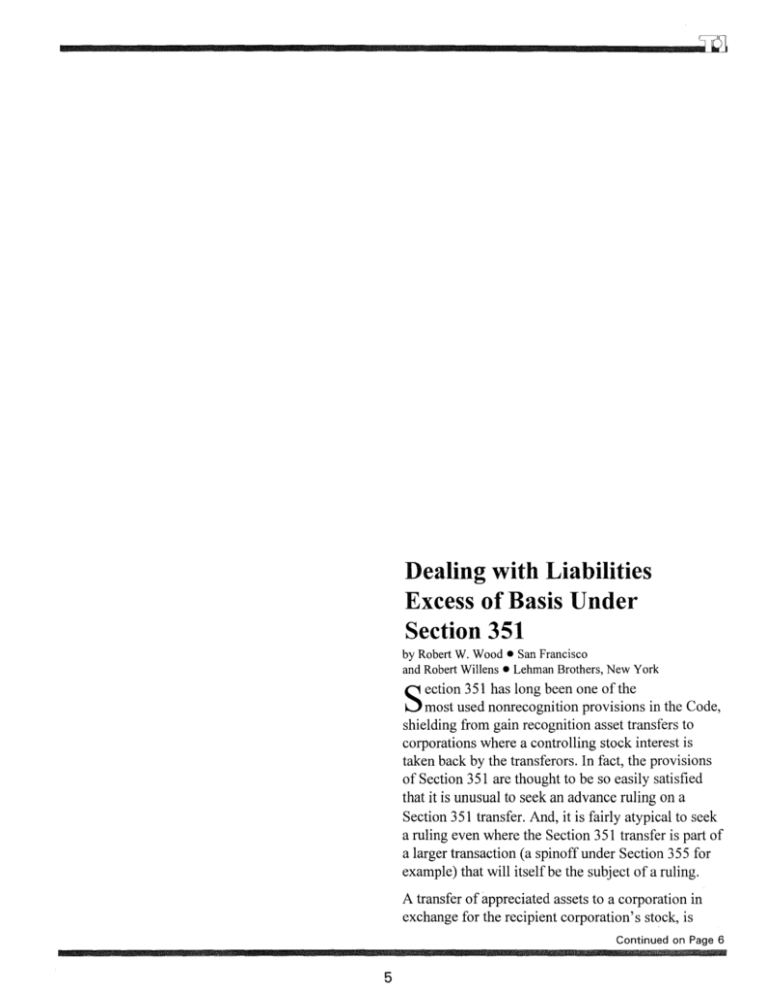
Dealing with Liabilities
Excess of Basis Under
Section 351
by Robert W. Wood - San Francisco
and Robert Willens - Lehman Brothers, New York
most used nomecognition provisions in the Code,
S
shielding from gain recognition asset transfers to
ection 351 has long been one of the
corporations where a controlling stock interest is
taken back by the transferors. In fact, the provisions
of Section 351 are thought to be so easily satisfied
that it is unusual to seek an advance ruling on a
Section 351 transfer. And, it is fairly atypical to seek
a ruling even where the Section 351 transfer is part of
a larger transaction (a spinoff under Section 355 for
example) that will itself be the subject of a ruling.
A transfer of appreciated assets to a corporation in
exchange for the recipient corporation's stock, is
Continued on Page 6
5
might go bankrupt. If this event transpired, the note
would attain great significance because the presence
of the note would allow the transferee's creditors to
reach the personal assets of the transferor. Where the
risk of bankruptcy is important enough to be
recognized (the court found that Mr. Peracchi's
transferee was an operating business that was subject
to more than a "non-trivial" risk of bankruptcy), the
transferor should get a basis in the transferred note.
Continued from Page 5
EXCESS LIABILITIES
eligible for nomecognition treatment under Section
351 as long as the transferors of property to the
corporation are in control of the corporation
immediately after the transfer. One of the few traps in
Section 351 relates to liabilities. Still, the fact that the
transferred property is encumbered by liabilities does
not deprive the transferor of tax-free treatment unless
the liabilities were created on the eve of the transfer
and the proceeds of the borrowing and the obligation
to repay the loan are separated as a result of the
incorporation. In that event, Section 357(b) will
likely apply to treat the debt assumption as the receipt
of "boot." Where boot is received in a Section 351
transaction, a transferor's realized gain is recognized
in an amount not exceeding the amount of the boot.
The note was considered to represent a new and
substantial increase in the transferor's investment in
the corporation and it was entirely proper for the
transferor to enjoy a basis step-up sufficient to
eliminate the spectre of Section 357(c). The court
found support for its approach in other parts of the
law which it interpreted to mean that a shareholder's
economic exposure (even though not accompanied by
an economic outlay) is the ultimate measure of the
shareholder's investment.
Liabilities Assumed
Where the sum of the liabilities assumed and those to
which the transferred property is subject exceed the
adjusted basis of the property transferred, Section
357(c) provides that the excess is a taxable gain. This
determination is made on a transferor by transferor
basis. (See Rev. Rul. 66-142.) The character of the
gain depends on the character of the assets transferred. A transferor may seek to avoid this unhappy
result by contributing to the corporation his personal
promissory note in an amount equal to the shortfall.
Nothing New?
Although Peracchi v. Commissioner has prompted a
good deal of commentary, and does squarely hold
that a shareholder who engages in a Section 351
exchange with his controlled corporation can avoid
gain recognition under Section 357(c) by contributing
his note along with encumbered property. Yet, at
least one other case deserves mention. Nearly ten
years ago, the Second Circuit, in a much publicized
decision, had concluded that the basis to which
Section 357(c) refers is the corporation's basis in the
contributed note, and not the shareholder's basis in
the note and his property. See Lessinger v.
Commissioner, 872 F.2d 519 (2d Cir. 1989).
However, the IRS has ruled that this strategy is
ineffective. See Rev. Rul. 68-629. According to the
IRS, the transfer of one's note does not increase the
basis of the assets conveyed to the corporation
because the basis of property is its cost and a
taxpayer incurs no cost in making a note.
One of the factors that the court in Peracchi
scrutinized was the real economic significance of the
note. It was important to the court that the note had
independent significance apart from the Section 351
exchange. Had the note from the shareholder not been
given as part of a Section 351 exchange, then its
potential real economic significance would justify
giving the shareholder a Section 1012 cost basis in
the stock received. However, if that same Section
1012 basis treatment were to apply in conjunction
with a Section 351 exchange, the note could not be
treated as property exchanged under Section 351.
A Note of Courage
There are indications that this somewhat harsh rule
may be changing. A recent Ninth Circuit decision
provides a glimmer of hope, standing in direct
conflict with the IRS' approach. Peracchi v.
Commissioner, 81 A.F.T.R.2d ~98-654 (9th Cir.
1998) stands for the proposition that a shareholder's
note (assuming it is worth approximately its face
amount) has a basis equal to its face amount and can
therefore mitigate a Section 357(c) gain.
In Peracchi, the court focused on the possibility that
the transferee (the holder of the transferor's note)
Continued on Page 7
6
EXCESS LIABILITIES
Continued from Page 6
"Exchanged basis" (not cost basis) in stock is what is
obtained in a Section 351 exchange. Thus, Section
357(c) would still apply to require recognition of any
debt encumbering the property (but not including the
note) in excess of the property's basis.
Mr. Peracchi had paid imperfect attention to his
obligations under the note. Still, a casual payment
history did not mean that the note was not genuine.
The Ninth Circuit said it was important to look at the
face of the note and to consider whether Peracchi' s
legal obligation was illusory.
Treating the contribution of the note as part of a
Section 351 exchange would preclude application of
the normal cost basis rules. The normal view would
be that a maker has no basis in his own note. This
notion is cast aside in the Peracchi case, where the
court felt strongly that a shareholder note given in a
Section 351 exchange should result in a cost basis in
the stock obtained. After all, this is the result that
occurs when a person's promissory note is used in a
purchase. The note provides basis in the purchased
assets. On the other hand, one can think of
circumstances in which a note does not provide basis.
Thus, a partner's note will not create basis in a
partnership interest. See Revenue Ruling 80-235,
1980-2 C.B. 229.
The Ninth Circuit found that it was not illusory,
noting that the IRS had stipulated that:
•
Peracchi was creditworthy;
•
the note bore a market rate of interest and had
a fixed term;
•
the IRS was not arguing that the note was
worth anything other than its face value;
•
there was no suggestion that the corporation
could not have borrowed against it or sold it
to raise cash; and
•
the note was fully transferable and
enforceable by third parties.
From these factors, the Ninth Circuit concluded that
the contribution of the note was not a bailout
transaction, in which Peracchi had paid cash and
transferred the economic risk of loss to lenders.
Instead, he remained fully liable for $1.06 million,
which surely neutralized any tax avoidance motive.
Although recognizing that there was bailout potential
in a circumstance such as this, the Ninth Circuit
directed the IRS to look for lack of business purpose.
The IRS in Peracchi had already stipulated that the
contribution of the realty to the corporation had a
business purpose. Thus, the Service was estopped to
argue a lack of business purpose in order to find tax
due under Section 357(b).
Good or Bad?
Some commentators have been highly critical of the
Peracchi case, saying that the Ninth Circuit has
created basis where there really should be none. The
court has also been accused of violating the terms of
Congress' pronouncements in Sections 351, 357(c)
and 358. (For one criticism, see Cummings, "Ninth
Circuit Avoids Lessinger Misstep, but Makes
Another," Tax Notes, May 11, 1998, p. 781.)
It is not a complete answer to these complaints that
Peracchi could have structured the transaction to
avoid this entire controversy. As one observer pointed out, Mr. Peracchi could have contracted with the
corporation to pay to the secured creditor directly the
debts to which the transferred property was subject.
Plus, he could have exonerated the property from the
burden of the debts. This, seemingly, would have
prevented the issue from arising in the first place.
Interestingly, the question has been raised whether
Peracchi applies equally to C corporations and S
corporations. The Peracchi case involved a note
contributed to a C corporation. There are suggestions
in the opinion that a C corporation does not funnel
losses to the shareholder, while an S corporation
does. Implicitly, the scrutiny on contributed
promissory notes may be greater in the S corporation
context.
Yet, not all commentators have been negative about
the Peracchi case. In fact, some commentators have
pointed out that the underpinning ofthe Peracchi
case and the Ninth Circuit's decision was the genuine
indebtedness of the note. The Tax Court had viewed
the note as a sham. When the matter reached the
Ninth Circuit, the Ninth Circuit acknowledged that
No Mistake
As one observer noted, for almost 30 years,
Continued on Page 8
7
_.
totaling $90. Arguably, Newco's stock is
worth roughly $10, but, because the liabilities
are disregarded, the corporation's basis for
Newco's stock is unaffected by their presence.
(Normally, in a Section 351 transaction, the
transferor's basis in the transferee's stock is
reduced by the sum of the liabilities that the
transferee corporation assumes). Thus, a sale
of the Newco stock will yield an immediate
capital loss of $90 that the transferor can
apply to offset capital gains.
Continued from Page 7
EXCESS LIABILITIES
practitioners have planned around Section 351
transfers by contributing high-basis, low-value
property in order to increase the aggregate tax basis,
more on a par with the debt that posed a risk of "boot"
classification in the transaction. Controlling
shareholders were often told to add cash to the
transaction even if it had to be borrowed.
Peracchi holds that a personal note will avoid the
Section 357 liability. Although it is premature to
suggest that the IRS would be willing to concede the
point, Jhis is at least good news. Certainly wherever
personal notes are used, their formalities and payment
terms should be strictly observed ifthe taxpayer
wants to avoid having a fight over the validity of the
debt. (For discussion, see Raby and Raby, "'Sorcery'
Creates Tax Basis from 'Piece of Paper,'" Tax Notes,
May 18,1998, p. A73.)
Last Word
The effect of this maneuver is to accelerate tax
deductions because the deductions associated with
the environmental problem (which the capital loss
replaces) may not ripen for an extended period of
time. Moreover, the purchaser of Newco should not
be disadvantaged. When the environmental liabilities
ripen, Newco will be entitled to the same mix of tax
deductions and capital expenditures that the seller
would have enjoyed had it retained the subject
properties. Thus, this strategy appears to be a very
good deal. The seller accelerates tax deductions that
are fully available to the buyer at the time the
underlying contingent obligations mature. •
Read narrowly, the Peracchi case stands for the
proposition that a transferor's note (with a value
approximating face) has a cognizable basis (so its
transfer can eliminate a potential Section 357(c) gain)
in cases where the risk of the transferee's bankruptcy
is more than remote. The practical effect of this
holding: gains otherwise taxable at the time of
incorporation can now be deferred until such time as
the transferor disposes of the transferee's stock in
which the former has a zero basis.
THE M&A TAXREf.iORT
DYes! .EfltElLnwsll~~c:ripti9(")to Thelll!~. TIJ}(
Report at· thepriceoJ.only$375JortwelveftHi
issues, including post~geandh~ndlingcharges~ I
Accelerating Losses
Certain liabilities are entirely disregarded in
determining whether a taxpayer has a prohibited
excess of liabilities over asset basis. Such liabilities
are those whose payment would give rise to a tax
deduction. (See Section 357(c)(3).) Moreover, in
Rev. Rul. 95-74, the IRS expanded the exemption to
encompass liabilities whose payment would not be
deductible but, instead, would give rise to capital
expenditures. In addition, the IRS concluded that the
transferee would step into the transferor's shoes with
respect to these inchoate deductions and capital.
en?l()se full p~Yinent bY.c:heck ()L cred it card. For
Mastercard .. andVisa ordeJ~,.enterGardlnformation
bel()VV or call {8()OL.852:,5515;Fu"mon~y~back
guarantee applies to unused part of subscription ;
DYesLEnter my sllt:>scriptiOnfof $375 and biUme;
Name
Title ~~~~---:""-:--~---';;'~~'-"':""~~--'-~-Firm
Stree-:-t--.....-~--~------------'-.....:;,,-:--......
City1St ate/Zip -:-"_ _.........'---~_..,...,..---,;;......:;"..,......---'----,;;._
Telephone (_)
o
Fo~r~C=r-e~d~it~C~a-r~d~O~r~d-er~s~:-:-----'----'-~=-
Mastercard # ____---.,.._-.....-__
E·xp. __.
Visa· #_-'-'--_ _'--'--_---,;;.__
Exp. _ .. _
.......
Authorized.·Signatllre -=~~"-..........;.;"-~---,;;.~.;;,;;;::.:.....:;"
o
~
111
Example: Assume a corporation transfers
assets with a basis and value of $1 00 to
Newco in exchange for all the latter's stock.
There are contingent environmental liabilities
associated with the assets that will ripen into
deductible items and capital expenditures
]~X·INSTiTUTE
?35M.9.1'}tg()meryStre~t#~7 2
Sall. Fnmciscoi··CA.~4104
e;,tnail:·• iofo@ta!'iosti!9t,.9()1tl
(8001852~&515
.. fa" {41.!nS34~jit3a8
8
